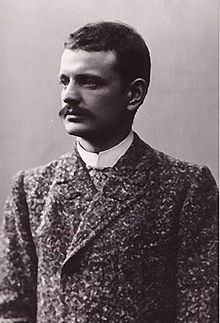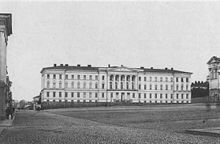| Revision as of 19:21, 17 February 2022 editOnkelringelhuth (talk | contribs)382 edits →In popular culture: add ref for "This Week" theme← Previous edit | Revision as of 17:58, 8 April 2022 edit undoRuxnor (talk | contribs)Extended confirmed users634 edits →In popular cultureTags: Reverted 2017 wikitext editorNext edit → | ||
| Line 54: | Line 54: | ||
| In the UK, the Intermezzo was used as the theme tune for the ] and ] TV show '']''.<ref>{{cite web|url=https://rediffusion.london/this-week-is-10-part-2|title=This Week is 10 – Part 2|publisher=The Transdiffusion Broadcasting System|access-date=17 February 2022|archive-date=14 November 2016}}</ref> It was also used in the "]" sketch on '']''.{{citation needed|date=February 2020}} | In the UK, the Intermezzo was used as the theme tune for the ] and ] TV show '']''.<ref>{{cite web|url=https://rediffusion.london/this-week-is-10-part-2|title=This Week is 10 – Part 2|publisher=The Transdiffusion Broadcasting System|access-date=17 February 2022|archive-date=14 November 2016}}</ref> It was also used in the "]" sketch on '']''.{{citation needed|date=February 2020}} | ||
| A |
A sped up version of the first ''Intermezzo'' is used by the Chilean TV station ] to introduce its sports broadcasts.<ref>{{Cite web |date=2014-06-09 |title=Himnos del Área Deportiva |trans-title=Anthems of the Sports Area |url=http://www.museopublicidad.cl/2014/06/himnos-del-area-deportiva/ |url-status=dead |archive-url=https://web.archive.org/web/20200626182454/http://www.museopublicidad.cl/2014/06/himnos-del-area-deportiva/ |archive-date=2020-06-26 |access-date=2021-12-19 |website=Museo de la Publicidad UDP |language=es-CL}}</ref> | ||
| The rock group ] recorded an arrangement of the Intermezzo which appeared on the album '']''. They later recorded a live version with the ], which appeared on the album '']''.<ref>{{cite web|url=http://www.allmusic.com/album/five-bridges-mw0000457441|title=Five Bridges - The Nice|publisher=AllMusic|access-date=16 January 2017|archive-date=14 November 2016|archive-url=https://web.archive.org/web/20161114084530/http://www.allmusic.com/album/five-bridges-mw0000457441|url-status=live}}</ref> | The rock group ] recorded an arrangement of the Intermezzo which appeared on the album '']''. They later recorded a live version with the ], which appeared on the album '']''.<ref>{{cite web|url=http://www.allmusic.com/album/five-bridges-mw0000457441|title=Five Bridges - The Nice|publisher=AllMusic|access-date=16 January 2017|archive-date=14 November 2016|archive-url=https://web.archive.org/web/20161114084530/http://www.allmusic.com/album/five-bridges-mw0000457441|url-status=live}}</ref> | ||
Revision as of 17:58, 8 April 2022
Symphonic suite by Jean Sibelius

Karelia Suite, Op. 11 is a subset of pieces from the longer Karelia Music (named after the region of Karelia) written by Jean Sibelius in 1893 for the Viipuri Students' Association and premiered, with Sibelius conducting, at the Imperial Alexander University in Helsinki, Grand Duchy of Finland, on 23 November of that year. Sibelius first conducted the shorter Suite ten days later; it remains one of his most popular works.
Karelia Music was written in the beginning of Sibelius's compositional career, and the complete Music consists of an Overture, 8 Tableaux, and 2 Intermezzi; it runs for about 44 minutes, whereas the Suite lasts about 12 minutes.
The rough-hewn character of the Music was deliberate – the aesthetic intention was not to dazzle with technique but to capture the quality of naive, folk-based authenticity. Historical comments have noted the nationalistic character of the music.
Orchestration
The piece is orchestrated for three flutes (3rd doubling piccolo), three oboes (3rd doubling english horn), two clarinets, two bassoons, four horns in F and E, three trumpets in F and E, three trombones, tuba, timpani, bass drum, cymbals, triangle, tambourine, two sopranos/baritones (Tableau 1), a baritone (Tableau 5), SATB choir (Tableau 8) and strings.
Ralph Wood has commented on the role of the percussion in this composition.
History
Ernst Lampén"The noise in the hall was like an ocean in a storm. I was at the opposite end of the hall and could not distinguish a single note. The audience did not have the patience to listen and was hardly aware of the music. The orchestra was actually there, behind the pillars. I thrust my way through the crowd and managed to reach the orchestra after a good deal of effort. There were a few listeners. Just a handful."
The movements in the suite are all borrowed from the Karelia Music, which consisted of an overture and eight tableaux. Sibelius was commissioned to write it in 1893 by the Viipuri Students' Association for a lottery to aid the education of the people of the Viipuri Province. Sibelius conducted the Karelian Music at its premiere on 13 November 1893 at the Imperial Alexander University in Helsinki, Grand Duchy of Finland. The behaviour of the audience was, however, far from ideal. As Sibelius noted later:
You couldn't hear a single note of the music – everyone was on their feet cheering and clapping.
— Jean Sibelius, in a letter to his brother Christian
Ten days later, Sibelius conducted a popular concert that included the Overture, followed by the three movements that would become the Karelia Suite. These four pieces were sold to Edition Fazer in 1899 and, at Sibelius's request, Overture and Karelia Suite were published as Op. 10 & 11, respectively. The rest of the Karelia Music pieces that were yet to be printed ended up in the hands of Breitkopf & Härtel in 1905.

The score was at some point left in the possession of Robert Kajanus and, in 1936, Kajanus's wife Ella returned it back to Sibelius. It is thought that Sibelius burned his eighth symphony along with most of the Karelia Music in August 1945, with only the 1st and 7th tableaux spared from the fire. The viola, cello and double bass parts are also missing from the 1st and 7th tableaux, and the flute parts are completely missing from the 7th tableau.
Composition
The original movements are as follows:
- Overture
- Tableau 1 – A Karelian home. News of War (1293)
- Tableau 2 – The founding of Viipuri Castle
- Tableau 3 – Narimont, the Duke of Lithuania, levying taxes in the province of Käkisalmi (1333)
- Intermezzo (I)
- Tableau 4 – Karl Knutsson in Viipuri Castle (1446)
- Tableau 5 – Pontus De la Gardie at the gates of Käkisalmi (1580)
- Intermezzo (II) (Originally titled Tableau 5+1⁄2) – Pontus de la Gardie's March)
- Tableau 6 – The Siege of Viipuri (1710)
- Tableau 7 – The Reunion of Old Finland (Karelia) with the rest of Finland (1811)
- Tableau 8 – The Finnish National Anthem
The suite is in three movements:
- The Intermezzo is the only original movement of the suite. Sibelius borrowed the brass theme in the middle of Tableau 3 and made it into its own movement. The Intermezzo is a jaunty Allegro march-like theme, the orchestra portraying the atmosphere of marching contingents.
- The Ballade was based on Tableau 4, and is 'sung' by a bard (on cor anglais), reflecting the mood of a fifteenth-century Swedish king, Karl Knutsson, reminiscing in his castle whilst being entertained by a minstrel.
- Alla Marcia is an exhilarating march, which was originally incidental to Tableau 5½ and is practically the same as the original music, except for some minor chord changes.
Completions of the original complete score
Most of the music was reconstructed in 1965 by Kalevi Kuosa, from the original parts that had survived. The parts that hadn't survived were those of the violas, cellos, and double basses. Based on Kuosa's transcription, the Finnish composers Kalevi Aho and Jouni Kaipainen have individually reconstructed the complete music to Karelia Music. A recording of Kalevi Aho's completion was released in 1997 in a recording with the Lahti Symphony Orchestra conducted by Osmo Vänskä, and Jouni Kaipainen's completion was recorded for a 1998 release with the Tampere Philharmonic Orchestra, conducted by Tuomas Ollila.
In popular culture
The suite was one of the 17 classical compositions used to create the title track of the 1981 Hooked on Classics project.
In the UK, the Intermezzo was used as the theme tune for the Associated-Rediffusion and Thames TV show This Week. It was also used in the "Piranha Brothers" sketch on Monty Python's Flying Circus.
A sped up version of the first Intermezzo is used by the Chilean TV station Televisión Nacional de Chile to introduce its sports broadcasts.
The rock group The Nice recorded an arrangement of the Intermezzo which appeared on the album Ars Longa Vita Brevis. They later recorded a live version with the Sinfonia of London, which appeared on the album Five Bridges.
References
- ^ "Incidental music: Karelia Music, Overture and Suite". sibelius.fi. Archived from the original on 20 July 2015.
- Lyle, Watson (1927). "The "Nationalism" of Sibelius". The Musical Quarterly. 13 (4): 617–629. doi:10.1093/mq/xiii.4.617.
- Wood, Ralph W. (1942). "Sibelius's Use of Percussion". Music & Letters. 23 (1): 10–23. doi:10.1093/ml/xxiii.1.10. JSTOR 728570.
- ^ "Inkpot #47: Sibelius: Complete Karelia and Kuolema Music (BIS)". inkpot.com. Archived from the original on 9 September 2015.
- Wise, Brian. "Karelia Suite, for orchestra, Op. 11". Allmusic. Archived from the original on 13 September 2015.
- ^ Aho, Kalevi. "Jean Sibeliuksen Karelia-musiikin rekonstruktionti ja täydentäminen". composers.musicfinland.fi. Archived from the original on 13 September 2015.
- "Sibelius - Karelia, complete score". bis.se. Archived from the original on 2 December 2013. Retrieved 24 February 2012.
- "SIBELIUS, J.: Karelia / Press Celebrations Music (Tampere Philharmonic)". naxos.com. Archived from the original on 13 September 2015. Retrieved 24 February 2015.
- "This Week is 10 – Part 2". The Transdiffusion Broadcasting System. Retrieved 17 February 2022.
{{cite web}}:|archive-date=requires|archive-url=(help) - "Himnos del Área Deportiva" [Anthems of the Sports Area]. Museo de la Publicidad UDP (in Spanish). 9 June 2014. Archived from the original on 26 June 2020. Retrieved 19 December 2021.
- "Five Bridges - The Nice". AllMusic. Archived from the original on 14 November 2016. Retrieved 16 January 2017.
External links
- Karelia Overture, Op.10: Scores at the International Music Score Library Project
- Karelia Suite, Op.11: Scores at the International Music Score Library Project
- Alla Marcia from Karelia Suite conducted by Robert Kajanus